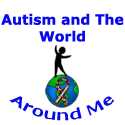EEG and ASD
>> Friday, March 27, 2009
In today's autism world, an EEG (electroencephalogram) can be useful. Individuals diagnosed with AD(H)D, learning disabilities and autism can learn how to control their brainwaves to sustain attention, increase concentration, improve sleep and decrease anxiety. Looks like I could use those three things. What about you? This is obtainable by super fast computers which are capable of handling real time data from the brain. How great is that?
Neurofeedback is a highly sophisticated version of biofeedback that allows the brain to "eavesdrop on itself" and learn how to alter it's own timing and the frequencies of its brainwave activity. Neurofeedback has emerged into a powerful therapy that teaches the brains of autism patients to function more efficient.
Brainwave frequencies are measured in cycles per second, or Hertz; therefore, one Hertz equals one cycle per second. EEG signals can be dominant; all occur simultaneously composed of many different frequencies, and are organized in frequency bands. The list below shows these bands and the mental state associated with each band, and may slightly vary from doctor to doctor.
Frequency Name, Cycles per second (Hertz), Mental State
Delta, <4, Sleep
Theta 4-7, Drowsy
Alpha 8-11, Inattentive
SMR ( Sensori-motor rhythm), 12-15, Calm
Beta, 16-20, Focused
High Beta, >20, Excited
Did you know that the brains with attention deficits demonstrate a dominance of low-freguency theta waves, which produce drowsy mental state, resulting in symptoms such as lethargy, poor focus, and compromised memory. That is right too many theta waves can disturb sleep making children feeling tired most of the time even a school.
Nurofeedback takes the form of a visual display with auditory signals, and occasionally tactile feedback. Visual display has the sole purpose of entertaining the subject and training the brain. This makes it possible for the training to proceed even with non-verbal individuals. The brain still tries to do its best (at an unconscious level) to adjust to the demands of its environment. regardless of the cognitive level of the person with autism and other spectrum disorders.
Types of neurofeedback can include hemoencephalography (blood-brain-image) or HEG, the Low Energy Neurofeedback System (LENS), and passive infrared thermal training (pIR). HEG uses a headband with infrared heat sensors that can detect blood flow within the brain. The LENSE system, invented by Len Ochs Ph.D, use a very low power electromagnetic fields, no larger than those that surround digital watches to carry feedback to the subject. Visit the LENSE link for more information or visit these other sources:
EEG Info
EEG Institute
BCIA
EEG Directory
ISNR
EEG Spectrum
AAPB
Brian Othmer Foundation
Source of info:
Envisioning a Bright Future by:
Patricia Lemer
Glitter Text Generator




0 special comments:
Post a Comment